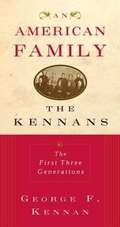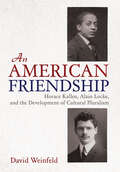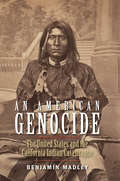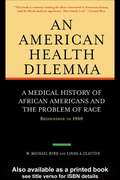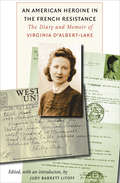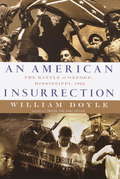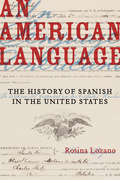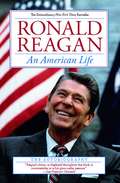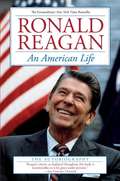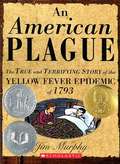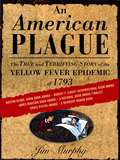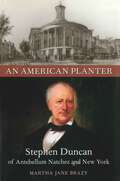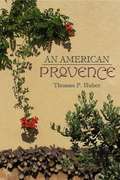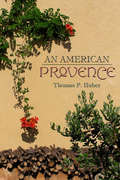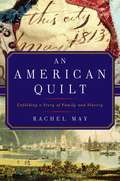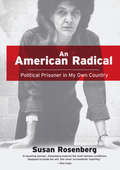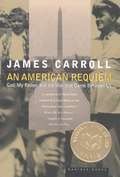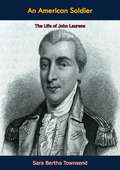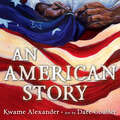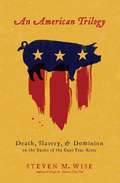- Table View
- List View
An American Family: The Kennans, The First Three Generations
by George F. KennanPulitzer Prize-winning author and former statesman George F. Kennan traces his roots back more than five generations, discovering in the process a family history with all the makings of a classic American story.
An American Friendship: Horace Kallen, Alain Locke, and the Development of Cultural Pluralism
by David WeinfeldIn An American Friendship, David Weinfeld presents the biography of an idea, cultural pluralism, the intellectual precursor to modern multiculturalism. He roots its origins in the friendship between two philosophers, Jewish immigrant Horace Kallen and African American Alain Locke, who advanced cultural pluralism in opposition to both racist nativism and the assimilationist "melting pot." It is a simple idea—different ethnic groups can and should coexist in the United States, perpetuating their cultures for the betterment of the country as whole—and it grew out of the lived experience of this friendship between two remarkable individuals. Kallen, a founding faculty member of the New School for Social Research, became a leading American Zionist. Locke, the first Black Rhodes Scholar, taught at Howard University and is best known as the intellectual godfather of the Harlem Renaissance and the editor of The New Negro in 1925. Their friendship began at Harvard and Oxford during the years 1906 through 1908 and was rekindled during the Great Depression, growing stronger until Locke's death in 1954. To Locke and Kallen, friendship itself was a metaphor for cultural pluralism, exemplified by people who found common ground while appreciating each other's differences. Weinfeld demonstrates how this understanding of cultural pluralism offers a new vision for diverse societies across the globe. An American Friendship provides critical background for understanding the conflicts over identity politics that polarize US society today.
An American Genocide: The United States and the California Indian Catastrophe, 1846-1873
by Benjamin MadleyBetween 1846 and 1873, California's Indian population plunged from perhaps 150,000 to 30,000. Benjamin Madley is the first historian to uncover the full extent of the slaughter, the involvement of state and federal officials, the taxpayer dollars that supported the violence, indigenous resistance, who did the killing, and why the killings ended. This deeply researched book is a comprehensive and chilling history of an American genocide. Madley describes pre-contact California and precursors to the genocide before explaining how the Gold Rush stirred vigilante violence against California Indians. He narrates the rise of a state-sanctioned killing machine and the broad societal, judicial, and political support for genocide. Many participated: vigilantes, volunteer state militiamen, U. S. Army soldiers, U. S. congressmen, California governors, and others. The state and federal governments spent at least $1,700,000 on campaigns against California Indians. Besides evaluating government officials' culpability, Madley considers why the slaughter constituted genocide and how other possible genocides within and beyond the Americas might be investigated using the methods presented in this groundbreaking book.
An American Health Dilemma: A Medical History of African Americans and the Problem of Race: Beginnings to 1900
by W. Michael Byrd Linda A. ClaytonAt times mirroring and at times shockingly disparate to the rise of traditional white American medicine, the history of African-American health care is a story of traditional healers; root doctors; granny midwives; underappreciated and overworked African-American physicians; scrupulous and unscrupulous white doctors and scientists; governmental support and neglect; epidemics; and poverty. Virtually every part of this story revolves around race. More than 50 years after the publication of An American Dilemma, Gunnar Myrdal's 1944 classic about race relations in the USA, An American Health Dilemma presents a comprehensive and groundbreaking history and social analysis of race, race relations and the African-American medical and public health experience. Beginning with the origins of western medicine and science in Egypt, Greece and Rome the authors explore the relationship between race, medicine, and health care from the precursors of American science and medicine through the days of the slave trade with the harrowing middle passage and equally deadly breaking-in period through the Civil War and the gains of reconstruction and the reversals caused by Jim Crow laws. It offers an extensive examination of the history of intellectual and scientific racism that evolved to give sanction to the mistreatment, medical abuse, and neglect of African Americans and other non-white people. Also included are biographical portraits of black medical pioneers like James McCune Smith, the first African American to earn a degree from a European university, and anecdotal vignettes,like the tragic story of "the Hottentot Venus", which illustrate larger themes.An American Health Dilemma promises to become an irreplaceable and essential look at African-American and medical history and will provide an invaluable baseline for future exploration of race and racism in the American health system.
An American Heroine in the French Resistance: The Diary and Memoir of Virginia D'Albert-Lake (World War Ii: The Global, Human, And Ethical Dimension Ser. #Vol. 9)
by Virginia D'Albert-LakeThis account by a woman who fought the Nazis alongside her husband is &“an indelible portrait of extraordinary strength of character&” (The New Yorker). Virginia Roush fell in love with Philippe d&’Albert-Lake during a visit to France in 1936; they married soon after. In 1943, they both joined the Resistance, where Virginia put her life in jeopardy as she sheltered downed airmen and later survived a Nazi prison camp. After the war, she stayed in France with Philippe, and was awarded the Légion d&’Honneur and the Medal of Honor. This book includes two rare documents—Virginia&’s diary of wartime France until her capture in 1944, and her prison memoir written immediately after the war. Together they offer &“an invaluable record of the workings of the French Resistance by one of the very few American women who participated in it&” (Providence Journal). &“A sharply etched and moving story of love, companionship, commitment, and sacrifice . . . This beautifully edited diary and memoir throw an original light on the French Resistance.&” —Robert Gildea, author of Marianne in Chains: In Search of the German Occupation, 1940–1945 &“At once a stunning self-portrait and dramatic narrative of a valorous young American woman . . . an exciting and gripping story.&” —Walter Cronkite
An American Iliad: The Story of the Civil War
by Charles P. RolandThis comprehensive history of the Civil War interweaves the story of battles and campaigns with accounts of the major political, diplomatic, social, and cultural events of the epoch and insightful sketches of the leading actors. The story of the Civil War is the epic of the American people.
An American Insurrection: James Meredith and the Battle of Oxford, Mississippi, 1962
by William DoyleIn 1961, a black veteran named James Meredith applied for admission to the University of Mississippi -- and launched a legal revolt against white supremacy in the most segregated state in America. Meredith's challenge ultimately triggered what Time magazine called "the gravest conflict between federal and state authority since the Civil War," a crisis that on September 30, 1962, exploded into a chaotic battle between thousands of white civilians and a small corps of federal marshals. To crush the insurrection, President John F. Kennedy ordered a lightning invasion of Mississippi by over 20,000 U.S. combat infantry, paratroopers, military police, and National Guard troops. Based on years of intensive research, including over 500 interviews, JFK's White House tapes, and 9,000 pages of FBI files, An American Insurrection is a minute-by-minute account of the crisis. William Doyle offers intimate portraits of the key players, from James Meredith to the segregationist Mississippi Governor Ross Barnett, to President John F. Kennedy and the federal marshals and soldiers who risked their lives to uphold the Constitution. The defeat of the segregationist uprising in Oxford was a turning point in the civil rights struggle, and An American Insurrection brings this largely forgotten event to life in all its drama, stunning detail, and historical importance.
An American Language: The History of Spanish in the United States (American Crossroads #49)
by Rosina LozanoAn American Language is a tour de force that revolutionizes our understanding of U.S. history. It reveals the origins of Spanish as a language binding residents of the Southwest to the politics and culture of an expanding nation in the 1840s. As the West increasingly integrated into the United States over the following century, struggles over power, identity, and citizenship transformed the place of the Spanish language in the nation. An American Language is a history that reimagines what it means to be an American—with profound implications for our own time.
An American Life
by Ronald ReaganRonald Reagan's autobiography is a work of major historical importance. Here, in his own words, is the story of his life--public and private--told in a book both frank and compellingly readable. Few presidents have accomplished more, or been so effective in changing the direction of government in ways that are both fundamental and lasting, than Ronald Reagan. Certainly no president has more dramatically raised the American spirit, or done so much to restore national strength and self-confidence. Here, then, is a truly American success story--a great and inspiring one. From modest beginnings as the son of a shoe salesman in Tampico, Illinois, Ronald Reagan achieved first a distinguished career in Hollywood and then, as governor of California and as president of the most powerful nation in the world, a career of public service unique in our history. Ronald Reagan's account of that rise is told here with all the uncompromising candor, modesty, and wit that made him perhaps the most able communicator ever to occupy the White House, and also with the sense of drama of a gifted natural storyteller. He tells us, with warmth and pride, of his early years and of the elements that made him, in later life, a leader of such stubborn integrity, courage, and clear-minded optimism. Reading the account of this childhood, we understand how his parents, struggling to make ends meet despite family problems and the rigors of the Depression, shaped his belief in the virtues of American life--the need to help others, the desire to get ahead and to get things done, the deep trust in the basic goodness, values, and sense of justice of the American people--virtues that few presidents have expressed more eloquently than Ronald Reagan. With absolute authority and a keen eye for the details and the anecdotes that humanize history, Ronald Reagan takes the reader behind the scenes of his extraordinary career, from his first political experiences as president of the Screen Actors Guild (including his first meeting with a beautiful young actress who was later to become Nancy Reagan) to such high points of his presidency as the November 1985 Geneva meeting with Mikhail Gorbachev, during which Reagan invited the Soviet leader outside for a breath of fresh air and then took him off for a walk and a man-to-man chat, without aides, that set the course for arms reduction and charted the end of the Cold War. Here he reveals what went on behind his decision to enter politics and run for the governorship of California, the speech nominating Barry Goldwater that first made Reagan a national political figure, his race for the presidency, his relations with the members of his own cabinet, and his frustrations with Congress. He gives us the details of the great themes and dramatic crises of his eight years in office, from Lebanon to Grenada, from the struggle to achieve arms control to tax reform, from Iran-Contra to the visits abroad that did so much to reestablish the United States in the eyes of the world as a friendly and peaceful power. His narrative is full of insights, from the unseen dangers of Gorbachev's first visit to the United States to Reagan's own personal correspondence with major foreign leaders, as well as his innermost feelings about life in the White House, the assassination attempt, his family--and the enduring love between himself and Mrs. Reagan. An American Life is a warm, richly detailed, and deeply human book, a brilliant self-portrait, a significant work of history.
An American Life: An Enhanced eBook with CBS Video
by Ronald ReaganRonald Reagan's autobiography is a work of major historical importance. Here, in his own words, is the story of his life--public and private--told in a book both frank and compellingly readable. Few presidents have accomplished more, or been so effective in changing the direction of government in ways that are both fundamental and lasting, than Ronald Reagan. Certainly no president has more dramatically raised the American spirit, or done so much to restore national strength and self-confidence. Here, then, is a truly American success story--a great and inspiring one. From modest beginnings as the son of a shoe salesman in Tampico, Illinois, Ronald Reagan achieved first a distinguished career in Hollywood and then, as governor of California and as president of the most powerful nation in the world, a career of public service unique in our history. Ronald Reagan's account of that rise is told here with all the uncompromising candor, modesty, and wit that made him perhaps the most able communicator ever to occupy the White House, and also with the sense of drama of a gifted natural storyteller. He tells us, with warmth and pride, of his early years and of the elements that made him, in later life, a leader of such stubborn integrity, courage, and clear-minded optimism. Reading the account of this childhood, we understand how his parents, struggling to make ends meet despite family problems and the rigors of the Depression, shaped his belief in the virtues of American life--the need to help others, the desire to get ahead and to get things done, the deep trust in the basic goodness, values, and sense of justice of the American people--virtues that few presidents have expressed more eloquently than Ronald Reagan. With absolute authority and a keen eye for the details and the anecdotes that humanize history, Ronald Reagan takes the reader behind the scenes of his extraordinary career, from his first political experiences as president of the Screen Actors Guild (including his first meeting with a beautiful young actress who was later to become Nancy Reagan) to such high points of his presidency as the November 1985 Geneva meeting with Mikhail Gorbachev, during which Reagan invited the Soviet leader outside for a breath of fresh air and then took him off for a walk and a man-to-man chat, without aides, that set the course for arms reduction and charted the end of the Cold War. Here he reveals what went on behind his decision to enter politics and run for the governorship of California, the speech nominating Barry Goldwater that first made Reagan a national political figure, his race for the presidency, his relations with the members of his own cabinet, and his frustrations with Congress. He gives us the details of the great themes and dramatic crises of his eight years in office, from Lebanon to Grenada, from the struggle to achieve arms control to tax reform, from Iran-Contra to the visits abroad that did so much to reestablish the United States in the eyes of the world as a friendly and peaceful power. His narrative is full of insights, from the unseen dangers of Gorbachev's first visit to the United States to Reagan's own personal correspondence with major foreign leaders, as well as his innermost feelings about life in the White House, the assassination attempt, his family--and the enduring love between himself and Mrs. Reagan. An American Life is a warm, richly detailed, and deeply human book, a brilliant self-portrait, a significant work of history.
An American Marriage: The Untold Story of Abraham Lincoln and Mary Todd
by Michael BurlingameAn enlightening narrative exploring an oft-overlooked aspect of the sixteenth president's life, An American Marriage reveals the tragic story of Abraham Lincoln&’s marriage to Mary Todd.Abraham Lincoln was apparently one of those men who regarded &“connubial bliss&” as an untenable fantasy. During the Civil War, he pardoned a Union soldier who had deserted the army to return home to wed his sweetheart. As the president signed a document sparing the soldier's life, Lincoln said: &“I want to punish the young man—probably in less than a year he will wish I had withheld the pardon.&” Based on thirty years of research, An American Marriage describes and analyzes why Lincoln had good reason to regret his marriage to Mary Todd. This revealing narrative shows that, as First Lady, Mary Lincoln accepted bribes and kickbacks, sold permits and pardons, engaged in extortion, and peddled influence. The reader comes to learn that Lincoln wed Mary Todd because, in all likelihood, she seduced him and then insisted that he protect her honor. Perhaps surprisingly, the 5&’2&” Mrs. Lincoln often physically abused her 6&’4&” husband, as well as her children and servants; she humiliated her husband in public; she caused him, as president, to fear that she would disgrace him publicly. Unlike her husband, she was not profoundly opposed to slavery and hardly qualifies as the &“ardent abolitionist&” that some historians have portrayed. While she providid a useful stimulus to his ambition, she often &“crushed his spirit,&” as his law partner put it. In the end, Lincoln may not have had as successful a presidency as he did—where he showed a preternatural ability to deal with difficult people—if he had not had so much practice at home.
An American Martyr in Persia: The Epic Life And Tragic Death Of Howard Baskerville
by Reza AslanIn this erudite and piercing biography, best-selling author Reza Aslan proves that one person’s actions can have revolutionary consequences that reverberate the world over. Little known in America but venerated as a martyr in Iran, Howard Baskerville was a twenty-two-year-old Christian missionary from South Dakota who traveled to Persia (modern-day Iran) in 1907 for a two-year stint teaching English and preaching the gospel. He arrived in the midst of a democratic revolution—the first of its kind in the Middle East—led by a group of brilliant young firebrands committed to transforming their country into a fully self-determining, constitutional monarchy, one with free elections and an independent parliament. The Persian students Baskerville educated in English in turn educated him about their struggle for democracy, ultimately inspiring him to leave his teaching post and join them in their fight against a tyrannical shah and his British and Russian backers. “The only difference between me and these people is the place of my birth," Baskerville declared, “and that is not a big difference.” In 1909, Baskerville was killed in battle alongside his students, but his martyrdom spurred on the revolutionaries who succeeded in removing the shah from power, signing a new constitution, and rebuilding parliament in Tehran. To this day, Baskerville’s tomb in the city of Tabriz remains a place of pilgrimage. Every year, thousands of Iranians visit his grave to honor the American who gave his life for Iran. In this rip-roaring tale of his life and death, Aslan gives us a powerful parable about the universal ideals of democracy—and to what degree Americans are willing to support those ideals in a foreign land. Woven throughout is an essential history of the nation we now know as Iran—frequently demonized and misunderstood in the West. Indeed, Baskerville’s life and death represent a “road not taken” in Iran. Baskerville’s story, like his life, is at the center of a whirlwind in which Americans must ask themselves: How seriously do we take our ideals of constitutional democracy and whose freedom do we support?
An American Plague: The True and Terrifying Story of the Yellow Fever Epidemic of 1793
by Jim MurphyNIMAC-sourced textbook <P><P>The true and terrifying story of the Yellow Fever Epidemic of 1793.
An American Plague: The True and Terrifying Story of the Yellow Fever Epidemic of 1793
by Jim MurphyNational Book Award Finalist: An account of the disease that ravaged eighteenth-century Philadelphia, written and illustrated for young readers. 1793, Philadelphia: The nation&’s capital and the largest city in North America is devastated by an apparently incurable disease, cause unknown… This dramatic narrative describes the illness known as yellow fever and the toll it took on the city&’s residents, relating the epidemic to the social and political events of the day and eighteenth-century medical beliefs and practices. Drawing on first-hand accounts, Jim Murphy spotlights the heroic role of Philadelphia&’s free blacks in combating the disease, and the Constitutional crisis President Washington faced when he was forced to leave the city—and all his papers—to escape the deadly contagion. The search for the fever's causes and cure provides a suspenseful counterpoint to this riveting true story of a city under siege. Winner of multiple awards, this thoroughly researched book offers a look at the conditions of cities at the time of our nation&’s birth, and draws timely parallels to modern-day epidemics. &“A lavishly illustrated book, containing maps, newspaper columns and period illustrations…unflinchingly presents the horrors of the event as well as its heroes.&”—The New York Times &“Pair this work with Laurie Halse Anderson&’s wonderful novel Fever 1793 and you&’ll have students hooked on history.&”—School Library Journal &“History, science, politics, and public health come together in this dramatic account of the disastrous yellow fever epidemic that hit the nation&’s capital more than 200 years ago.&”—Booklist
An American Planter: Stephen Duncan of Antebellum Natchez and New York (Southern Biography Series)
by Martha Jane BrazyExtraordinarily wealthy and influential, Stephen Duncan (1787-1867) was a landowner, slaveholder, and financier with a remarkable array of social, economic, and political contacts in pre-Civil War America. In this, the first biography of Duncan, Martha Jane Brazy offers a compelling new portrait of antebellum life through exploration of Duncan's multifaceted personal networks in both the South and the North. Duncan grew up in an elite Pennsylvania family with strong business ties in Philadelphia. There was little indication, though, that he would become a cosmopolitan entrepreneur who would own over fifteen plantations in Mississippi and Louisiana, collectively owning more than two thousand slaves. With style and substance, Martha Jane Brazy describes both the development of Duncan's businesses and the lives of the slaves on whose labor his empire was constructed. According to Brazy, Duncan was a hybrid, not fully a southerner or a northerner. He was also, Brazy shows, a paradox. Although he put down deep roots in Natchez, his sphere of influence was national in scope. Although his wealth was greatly dependent on the slaves he owned, he predicted a clash over the issue of slave ownership nearly three decades before the onset of the Civil War. Perhaps more than any other planter studied, Duncan contradicts historians' definition of the southern slaveholding aristocracy. By connecting and contrasting the networks of this elite planter and those he enslaved, Brazy provides new insights into the slaveocracy of antebellum America.
An American Planter: Stephen Duncan of Antebellum Natchez and New York (Southern Biography Series)
by Martha Jane BrazyExtraordinarily wealthy and influential, Stephen Duncan (1787–1867) was a landowner, slaveholder, and financier with a remarkable array of social, economic, and political contacts in pre-Civil War America. In this, the first biography of Duncan, Martha Jane Brazy offers a compelling new portrait of antebellum life through exploration of Duncan's multifaceted personal networks in both the South and the North. Duncan grew up in an elite Pennsylvania family with strong business ties in Philadelphia. There was little indication, though, that he would become a cosmopolitan entrepreneur who would own over fifteen plantations in Mississippi and Louisiana, collectively owning more than two thousand slaves. With style and substance, Martha Jane Brazy describes both the development of Duncan's businesses and the lives of the slaves on whose labor his empire was constructed. According to Brazy, Duncan was a hybrid, not fully a southerner or a northerner. He was also, Brazy shows, a paradox. Although he put down deep roots in Natchez, his sphere of influence was national in scope. Although his wealth was greatly dependent on the slaves he owned, he predicted a clash over the issue of slave ownership nearly three decades before the onset of the Civil War. Perhaps more than any other planter studied, Duncan contradicts historians' definition of the southern slaveholding aristocracy. By connecting and contrasting the networks of this elite planter and those he enslaved, Brazy provides new insights into the slaveocracy of antebellum America.
An American Provence
by Thomas P. Huber"I have talked about luscious wines and succulent fruit and exquisite dinners. But there may be no more evocative experience of the two valleys than the smell of new-mown hay in the fields at dusk. If a person were to close their eyes, they could not tell if they were in Provence or the North Fork Valley. That sweet, earthy odor is part of the beauty of these places." -From An American Provence In this poetic personal narrative, Thomas P. Huber reflects on two seemingly unrelated places-the North Fork Valley in western Colorado and the Coulon River Valley in Provence, France-and finds a shared landscape and sense of place. What began as a simple comparison of two like places in distant locations turned into a more complex, interesting, and personal task. Much is similar-the light, the valleys, the climate, the agriculture. And much is less so-the history, the geology, the physical makeup of villages. Using a geographer's eye and passion for the land and people, Huber examines the regions' similarities and differences to explore the common emotional impact of each region. Part intimate travelogue and part case study of geography in the real world, An American Provence illuminates the importance sense of place plays in who we are.
An American Provence
by Thomas P. Huber"I have talked about luscious wines and succulent fruit and exquisite dinners. But there may be no more evocative experience of the two valleys than the smell of new-mown hay in the fields at dusk. If a person were to close their eyes, they could not tell if they were in Provence or the North Fork Valley. That sweet, earthy odor is part of the beauty of these places." -From An American Provence In this poetic personal narrative, Thomas P. Huber reflects on two seemingly unrelated places-the North Fork Valley in western Colorado and the Coulon River Valley in Provence, France-and finds a shared landscape and sense of place. What began as a simple comparison of two like places in distant locations turned into a more complex, interesting, and personal task. Much is similar-the light, the valleys, the climate, the agriculture. And much is less so-the history, the geology, the physical makeup of villages. Using a geographer's eye and passion for the land and people, Huber examines the regions' similarities and differences to explore the common emotional impact of each region. Part intimate travelogue and part case study of geography in the real world, An American Provence illuminates the importance sense of place plays in who we are.
An American Quilt: Unfolding A Story Of Family And Slavery
by Rachel MayFollowing the trail left by an unfinished quilt, this illuminating saga examines slavery from the cotton fields of the South to the textile mills of New England—and the humanity behind it. When we think of slavery, most of us think of the American South. We think of back-breaking fieldwork on plantations. We don’t think of slavery in the North, nor do we think of the grueling labor of urban and domestic slaves. Rachel May’s rich new book explores the far reach of slavery, from New England to the Caribbean, the role it played in the growth of mercantile America, and the bonds between the agrarian south and the industrial north in the antebellum era—all through the discovery of a remarkable quilt. While studying objects in a textile collection, May opened a veritable treasure-trove: a carefully folded, unfinished quilt made of 1830s-era fabrics, its backing containing fragile, aged papers with the dates 1798, 1808, and 1813, the words “shuger,” “rum,” “casks,” and “West Indies,” repeated over and over, along with “friendship,” “kindness,” “government,” and “incident.” The quilt top sent her on a journey to piece together the story of Minerva, Eliza, Jane, and Juba—the enslaved women behind the quilt—and their owner, Susan Crouch. May brilliantly stitches together the often-silenced legacy of slavery by revealing the lives of these urban enslaved women and their world. Beautifully written and richly imagined, An American Quilt is a luminous historical examination and an appreciation of a craft that provides such a tactile connection to the past.
An American Radical: Political Prisoner in My Own Country
by Susan RosenbergOn a November night in 1984, Susan Rosenberg sat in the passenger seat of a U-Haul as it swerved along the New Jersey Turnpike. At the wheel was a fellow political activist. In the back were 740 pounds of dynamite and assorted guns. That night I still believed with all my heart that what Che Guevara had said about revolutionaries being motivated by love was true. I also believed that our government ruled the world by force and that it was necessary to oppose it with force. Raised on New York City's Upper West Side, Rosenberg had been politically active since high school, involved in the black liberation movement and protesting repressive U.S. policies around the world and here at home. At twenty-nine, she was on the FBI's Most Wanted list. While unloading the U-Haul at a storage facility, Rosenberg was arrested and sentenced to an unprecedented 58 years for possession of weapons and explosives. I could not see the long distance I had traveled from my commitment to justice and equality to stockpiling guns and dynamite. Seeing that would take years.Rosenberg served sixteen years in some of the worst maximum-security prisons in the United States before being pardoned by President Clinton as he left office in 2001. Now, in a story that is both a powerful memoir and a profound indictment of the U.S. prison system, Rosenberg recounts her journey from the impassioned idealism of the 1960s to life as a political prisoner in her own country, subjected to dehumanizing treatment, yet touched by moments of grace and solidarity. Candid and eloquent, An American Radical reveals the woman behind the controversy--and reflects America's turbulent coming-of-age over the past half century.
An American Requiem: God, My Father, and the War that Came Between Us
by James CarrollNational Book Award winner: This story of a family torn apart by the Vietnam era is &“a magnificent portrayal of two noble men who broke each other&’s hearts&” (Booklist). James Carroll grew up in a Catholic family that seemed blessed. His father, who had once dreamed of becoming a priest, instead began a career in J. Edgar Hoover&’s FBI, rising through the ranks and eventually becoming one of the most powerful men in the Pentagon, the founder of the Defense Intelligence Agency. Young Jim lived a privileged life, dating the daughter of a vice president and meeting the pope—all in the shadow of nuclear war, waiting for the red telephone to ring in his parents&’ house. James fulfilled the goal his father had abandoned, becoming a priest himself. His feelings toward his father leaned toward worship as well—until the tumult of the 1960s came between them. Their disagreements, over Martin Luther King, Jr. and the civil rights movement; turmoil in the Church; and finally, Vietnam—where the elder Carroll chose targets for US bombs—began to outweigh the bond between them. While one of James&’s brothers fled to Canada, another was in law enforcement ferreting out draft dodgers. James, meanwhile, served as a chaplain at Boston University, protesting the war in the streets but ducking news cameras to avoid discovery. Their relationship would never be the same again. Only after Carroll left the priesthood to become a writer, and a husband with children of his own, did he begin to understand fully the struggles his father had faced. In An American Requiem, the New York Times bestselling author of Constantine&’s Sword and Christ Actually offers a benediction, in &“a moving memoir of the effect of the Vietnam War on his family that is at once personal and the story of a generation . . . at once heartbreaking and heroic, this is autobiography at its best&” (Publishers Weekly).
An American Soldier: The Life of John Laurens
by Henry Laurens Sara Bertha Townsend John LaurensOriginally published in 1958, this is the biography of John Laurens (1754-1782), an American soldier and statesman from South Carolina during the American Revolutionary War, best known for his criticism of slavery and his efforts to help recruit slaves to fight for their freedom as U.S. soldiers.In the author’s own words, Laurens hailed from an era that “knew nothing of flamethrowers and submarines, of atomic bombs and guided missiles. To the young republic this man gave his utmost devotion, acting within five momentous years the roles of soldier, legislator, aide-de-camp to the Commander-in-Chief, and Special Minister to France.”
An American Story
by Kwame Alexander#1 New York Times Bestselling and award-winning author of The Undefeated, Kwame Alexander, pens a powerful picture book that tells the story of American slavery through the voice of a teacher struggling to help her students understand its harrowing history. From the fireside tales in an African village, through the unspeakable passage across the Atlantic, to the backbreaking work in the fields of the South, this is a story of a people's struggle and strength, horror and hope. This is the story of American slavery, a story that needs to be told and understood by all of us. A testament to the resilience of the African American community, this book honors what has been and envisions what is to be. With stunning mixed-media illustrations by newcomer Dare Coulter, this is a potent book for those who want to speak the truth. Perfect for family sharing, the classroom, and homeschooling.
An American Trilogy
by Steven M. WiseThe Cape Fear River runs through Bladen County, North Carolina, population 33,000. On its western bank, in the town of Tar Heel, sits the largest slaughterhouse in the world. Deep below the slaughterhouse, one may find the arrowheads of Siouan-speaking peoples who roamed there for a millennium. Nearer the surface is evidence of slaves who labored there for a century. And now, the slaughterhouse kills the population of Bladen County, in hogs, every day.In this remarkable account, Wise traces the history of today's deadly harvest. From the colonies to the slave trade, from the artificial conception and unrecorded death of one single pig to the surreal science of the pork industry-whose workers continue the centuries of oppression-he unveils a portrait of this nation through the lives of its most vulnerable. His explorations ultimately lead to hope from a most unlikely source: the Baptist clergy, a voice in this wilderness proclaiming a new view of creation.
An American Type: A Novel
by Henry Roth“His early novel Call It Sleep was his Ulysses. His late work An American Type is his Grapes of Wrath.”—Thane Rosenbaum, Los Angeles Times This “glorious, evocative, literary novel for the ages” (Los Angeles Times) has finally taken its place within the great canon of American fiction. Set during the Great Depression, against a backdrop of New York’s glimmering skyscrapers and Los Angeles’s seedy motor courts, this autobiographical work concludes the unparalleled saga of Henry Roth, whose classic Call It Sleep, published in 1934, went on to become one of Time’s 100 best American novels of the twentieth century. With echoes of Nathanael West and John Steinbeck, An American Type is a heartrending statement about American identity and the universal transcendence of love.
